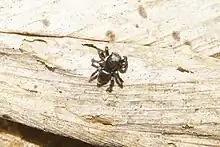| Stenaelurillus bandama | |
|---|---|
 | |
| A spider of the Stenaelurillus genus | |
| Scientific classification | |
| Domain: | Eukaryota |
| Kingdom: | Animalia |
| Phylum: | Arthropoda |
| Subphylum: | Chelicerata |
| Class: | Arachnida |
| Order: | Araneae |
| Infraorder: | Araneomorphae |
| Family: | Salticidae |
| Subfamily: | Salticinae |
| Genus: | Stenaelurillus |
| Species: | S. bandama |
| Binomial name | |
| Stenaelurillus bandama Logunov & Azarkina, 2018 | |
Stenaelurillus bandama is a species of jumping spider in the genus Stenaelurillus that lives in Ivory Coast. Named after the country where it was first found, it was first described in 2018 by Dmitri Logunov and Galina Azarkina. The spider is small, with a carapace between 2.45 and 2.55 mm (0.096 and 0.100 in) long and abdomen between 2.4 and 3.1 mm (0.094 and 0.122 in) long, although the female is larger than the male. They also differ in colouration. The male carapace is brown and has two white stripes unlike the female's yellow carapace. The male abdomen is dark brown has a pattern of spots and stripes while the female is lighter brown and has a single spot and speckles. The clypeus and legs are also brownish-yellow on the male and yellow on the female. It is similar to Stenaelurillus hirsutus, Stenaelurillus iubatus and Stenaelurillus striolatus but can be distinguished by the lack of hair and presence of a wider vertical stripe on the clypeus, the male's narrow embolus and the female's elongated pocket in the epigyne.
Taxonomy
Stenaelurillus bandama was first described by Dmitri Logunov and Galina Azarkina in 2018.[1] They placed the species in the genus Stenaelurillus, first raised by Eugène Simon in 1886.[2] The genus name relates to the genus name Aelurillus, which itself derives from the Greek word for cat, with the addition of a Greek stem meaning narrow.[3] It was placed in the subtribe Aelurillina in the tribe Aelurillini by Wayne Maddison in 2015, who listed the tribe in the clade Saltafresia.[4] Two years later, in 2017, it was grouped with nine other genera of jumping spiders under the name Aelurillines.[5] The species is named after the Bandama River, which runs near to the place the species was first found.[6]
Description
The spider is medium-sized. The male has a brown carapace that is 2.45 mm (0.096 in) long and 1.8 mm (0.071 in) wide. It is covered in dark brown scales and has two wide stripes made of white scales. The abdomen is dark brown on top and yellow underneath, and 2.4 mm (0.094 in) long and 1.5 mm (0.059 in) wide. It has three white spots and two stripes across the top and four stripes of brown hair underneath. The chelicerae and clypeus are brownish yellow, and feature white iridescent hairs. The legs and pedipalps are also brownish-yellow, but the legs have brown and yellow hairs while those on the pedipalps are long and white. The palpal bulb is elongated while the embolus is shaped like a nail.[7] The male is similar to Stenaelurillus hirsutus, but differs in having wide vertical stripes on the clypeus and the narrowness of the embolus.[6] It can be distinguished from Stenaelurillus striolatus by the lack of a hair cover to the clypeus.[8]
The female is similar to the male in shape but slightly larger. It has a yellow carapace 2.55 mm (0.100 in) long and 1.9 mm (0.075 in) wide that is covered in brown scales. The abdomen has a length of 3.1 in (79 mm) and width of 2.45 mm (0.096 in) and is brown with light yellow sides. It is a pattern of brown elongated speckles and a long white spot on the top. The clypeus and legs are also yellow. The epigyne is flat with a deep pocket. The copulatory openings are orientated transversely and line up close to a furrow in the middle of the epigyne. It has short insemination ducts and large round spermathecae.[9] The female can be confused with Stenaelurillus iubatus, but can be distinguished by the longer pocket in the epigyne and shorter insemination ducts.[6]
Distribution and habitat
The species is endemic to Ivory Coast.[1] The holotype was identified based on a specimen collected near Korhogo on the Bandama River in 1980.[6] It is known only from that local area.[10] It has been found in areas of riparian forest and savanna.[6]
References
Citations
- 1 2 World Spider Catalog (2021). "Stenaelurillus bandama Logunov & Azarkina, 2018". World Spider Catalog. 22.0. Bern: Natural History Museum. Retrieved 17 May 2021.
- ↑ Logunov 2020, p. 202.
- ↑ Fernández-Rubio 2013, p. 125.
- ↑ Maddison 2015, p. 279.
- ↑ Prószyński 2017, p. 95.
- 1 2 3 4 5 Logunov & Azarkina 2018, p. 22.
- ↑ Logunov & Azarkina 2018, pp. 22–24.
- ↑ Logunov & Azarkina 2018, p. 103.
- ↑ Logunov & Azarkina 2018, pp. 24–25.
- ↑ Logunov & Azarkina 2018, p. 25.
Bibliography
- Fernández-Rubio, Fidel (2013). "La etimología de los nombres de las arañas (Araneae)" [The etymology of the names of spiders (Araneae)]. Revista ibérica de Aracnología (in Spanish) (22): 125–130. ISSN 1576-9518.
- Logunov, Dmitri V. (2020). "Further notes on the genus Stenaelurillus Simon, 1885 from India (Araneae: Salticidae)". Zootaxa. 4899 (1): 201–214. doi:10.11646/zootaxa.4899.1.11. PMID 33756833. S2CID 232339218.
- Logunov, Dmitri V.; Azarkina, Galina N. (2018). "Redefinition and partial revision of the genus Stenaelurillus Simon, 1886 (Arachnida, Araneae, Salticidae)". European Journal of Taxonomy. 430: 1–126. doi:10.5852/ejt.2018.430.
- Maddison, Wayne P. (2015). "A phylogenetic classification of jumping spiders (Araneae: Salticidae)". The Journal of Arachnology. 43 (3): 231–292. doi:10.1636/arac-43-03-231-292. S2CID 85680279.
- Prószyński, Jerzy (2017). "Pragmatic classification of the World's Salticidae (Araneae)". Ecologica Montenegrina. 12: 1–133. doi:10.37828/em.2017.12.1.